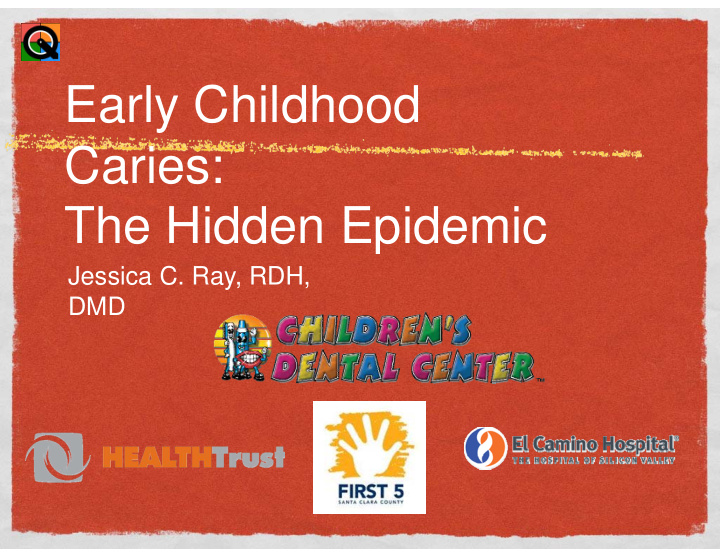



Early Childhood Caries: The Hidden Epidemic Jessica C. Ray, RDH, DMD
ECC- Early Childhood Caries What is ECC- Early Childhood Caries? How do we identify ECC? Children’s Dental Center Statistics How do we treat ECC? How do we prevent ECC?
What is ECC? Formerly known as “ Nursing Bottle Caries” or “Baby Bottle Caries” After 2 decades of collecting data on this distinctive clinical presentation of caries in children younger than 6 years old, the American Academy of Pediatric Dentistry (AAPD) adopted the term “ Early Childhood Caries” (ECC).
ECC-Early Childhood Caries Dental caries is a chronic infectious disease resulting from a specific bacteria called mutans streptococci (MS). MS can metabolize sugars to produce acids which can start to demineralize tooth structure. The acidic environment causes the enamel of the teeth to dissolve, which is the beginning of caries.
Mutans Streptococci (MS) Dental caries--a transmissible infectious disease- -can be transmitted from caregiver to child through salivary contact. MS can be transmissible between family members or other children in daycare. Methods of transmission include: sharing of utensils or toothbrushes, orally cleansing pacifiers, or saliva exchange.
Sugar and ECC Risk Children aged 6 months to 5 years who are frequently exposed to sugary liquids are at increased risk of developing ECC. Children who are exposed for long periods of time--drinking sugary liquids from a bottle or nursing all day--and children going to sleep with sugary liquids without wiping or brushing newly erupting teeth are at HIGH RISK!
Identifying ECC ECC is identified in children as young as one year, and is common in children 3-5 years old. ECC is most prevalent in children from families of lower socioeconomic status (SES). High incidence of ECC in ethnic minority groups, particularly in the Hispanic community.
Surgeon General Report on Oral Health--2009 Update • ECC is the most serious and costly health condition among young children. • Children 5-7 years old in the US have been estimated to lose more the 7 million school hours annually due to dental problems that started when they were preschoolers.
Identifying ECC If there is one or more carious lesion, one or more missing teeth due to a carious lesion, or one or more filled tooth surfaces in ANY primary teeth in a child under 6 years old, then it is considered ECC.
Children’s Dental Center Stats Year Patients Visits 2008 185 212 2009 4,970 9,568 2010 6,835 13,375 2011 9,331 18,427 2012 8,738 27,569 2013 16,279 31,639 2014 18,744 35,364
Number of Visits by Age (0- 17)
IV Sedation Grant • Thanks to efforts from First 5 & The Since Grant Awarded Health Trust, an IV Sedation Grant was Start date Cases San Jose 2/14/13 - 315 executed in Sunnyvale 9/11/14 - 18 December 2012 to Total Cases 333 treat children under 5 years old with IV Sedation (General Anesthesia).
Treating ECC • Treatments for ECC include: fillings, stainless steel crowns, porcelain crowns, pulpotomys, and extractions. • Children are often treated with Nitrous Oxide, Oral conscious sedation (midazolam) or IV sedation (General Anesthesia).
Prevention of ECC AAPD - American Academy of Pediatric Dentistry recommends all children see a dentist by their first birthday or after the eruption of their first primary tooth. Children should establish a dental “home” by age one. Parents should brush or wipe teeth twice daily, using a smear of fluoridated toothpaste for children under 3 yrs. and a pea-sized drop for children 3-6 yrs.
Collaborative Preventative Measures • Educating parents early--especially mothers during pregnancy--during prenatal classes, in maternity centers and with lactation nurses. • Dentists providing education & training in early oral health care instruction at medical healthcare centers, preschools and family resource centers. • Training for medical nurses, health aids, teachers and school nurses in identifying ECC.
Collaborative Preventative Measures • We need to continue to support the implementation of fluoridation in Santa Clara Valley Water district and San Jose Water Company. • Thanks to The Health Trust, First 5, and the California Dental Association (CDA)--they are at the front lines in making it happen in Santa Clara County!
Our Team • Dr. Filler Dr. Naftalin • Dr. Yang Dr. Yen • Dr. Hsu Dr. Moezzi • Dr. Phen Dionisio Palencia • Dr. Subramanian • Dr. Rakow • Dr. Chauhan • Dr. Rattan • Dr. Gill • Dr. Yeung
In Memory of Dr. Scott Jacks 1949-2014
References • American Academy of Pediatric Dentistry. Policy on Early Childhood Caries (ECC): Classifications, Consequences, and Preventive Strategies. The 2014 revision. • N. Tinanoff DDS, MS, S. Reisine, PhD. Update on Early Childhood Caries since Surgeon General’s Report. Academy Pediatrics. 2009 Nov.- Dec; 9(6): 396-403. • Gift HC, Reisine ST, Larch PC. The social impact of dental problems and visits. Am J Pub Hlth. 1992;82:1663-1668.
Recommend
More recommend